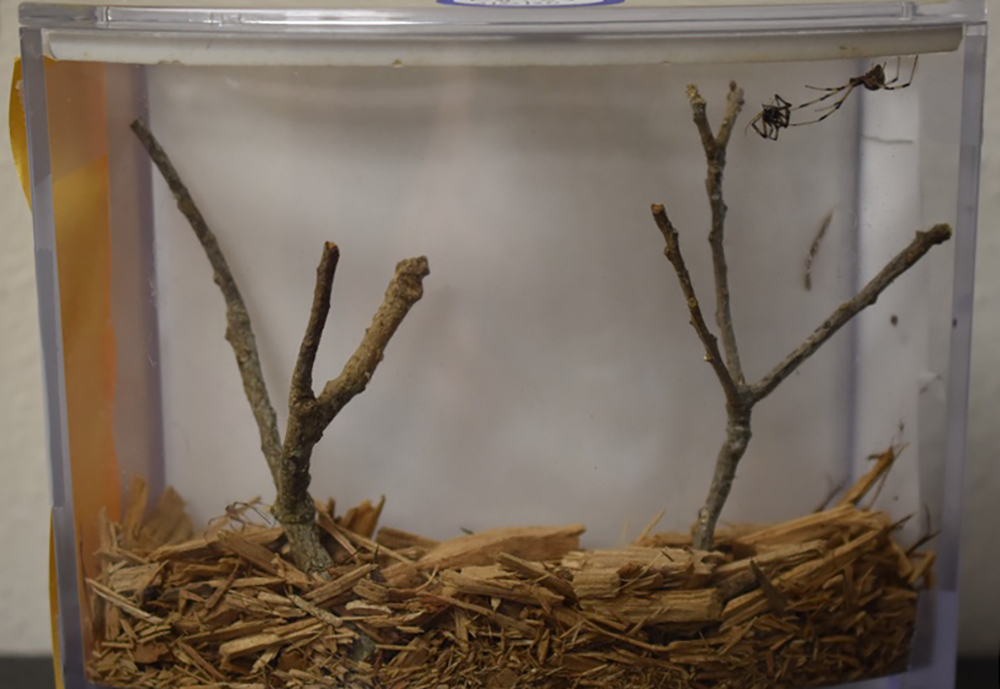By Matthew Cimitile, University Communications and Marketing
Brown widow spiders are seeking out and killing their black widow relatives, a surprising twist in the natural relationship between species of spiders known for their venomous bites, according to a new study.
Researchers at the University of South Florida’s St. Petersburg campus found that in a container habitat, brown widows were 6.6 times more likely to attack black widows than other related species. The behavior is likely a driver of the black widow spider’s population decline.
“We have established brown widow behavior as being highly aggressive towards the southern black widows, yet much more tolerant of other spiders within the same family,” said Louis Coticchio, who led the study as part of his undergraduate research at USF along with advisor Deby Cassill, associate professor in the Department of Integrative Biology.
Their findings were published on March 13, 2023, in the Annals of the Entomological Society of America. The study also revealed that both brown and black widow species are more likely to die of predation than starvation, suggesting that “competition for scarce resources is not a significant cause of mortality among spiderlings for either species,” the researchers said.
“We didn't expect to find such a dramatic and consistent difference in the personalities of the brown widow and the black widow,” Cassill said. “Brown widows are boldly aggressive and will immediately investigate a neighbor and attack if there is no resistance from the neighbor. The black widows are extremely shy, counterattacking only to defend themselves against an aggressive spider.”
Video caption: In a container habitat set up by USF researchers, brown widows were 6.6 times more likely to attack black widows than other related species. The behavior is likely a driver of the black widow spider’s population decline according to a new study.
Brown widow spiders are believed to be native to Africa, but have been introduced on all continents except Antarctica. Black widow spiders are native to North America and comprise two closely related species: the western black widow and the southern black widow.
In the past couple decades, researchers have noticed black widow spiders commonly being displaced by the brown widow. This new research suggests this isn’t a simple case of one species winning the competition for food or habitat, but instead a case of predation.
Coticchio, who spent the first part of his career as a zookeeper specializing in venomous animals in California before returning to Florida to earn a degree in biology, began collecting wild spiders in Florida for a research project. In doing so, he noticed brown widows displacing black widows but not other related species.
“I had a sneaking suspicion that Florida in particular provided plenty of food and habitat for both the brown and black widow, and that there was possibly some other area such as behavioral differences that was playing a role,” Coticchio said.
Coticchio partnered with Cassill and spider expert Richard Vetter of the University of California, Riverside, and devised a study to explore why brown widows were displacing black widows.
An aspect of the study placed brown widows in proximity with black widows and other spider species. When brown and black widow sub-adult females were paired, the brown widows killed and consumed the black widows in 80 percent of pairings, compared to just 40 percent of predation killings with red house spiders and 10 percent with triangulate cobweb spiders. In pairings of adults, black widows were killed in 40 percent of trials, while they defensively killed brown widows 30 percent of the time.
Though the study characterizes brown widow spiders as aggressive toward black widows, that isn’t the case when it pertains to humans. Brown widow venom causes less severe reactions to humans than black widows, and bites to people are very rare.
The researchers hope to answer next what drives such aggression between the closely related species.
“One question I would love to answer is how brown widows interact with other species of spiders, more specifically black widows in Africa, where brown widows are believed to have originated,” Coticchio said. “I want to see if their behavior and displacement of black widows is something that they have adapted here in North America, or if this behavior is something they exhibit naturally even in areas where they have coevolved with black widows for much longer periods of time.”
